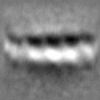+ Open data
Open data
- Basic information
Basic information
| Entry | 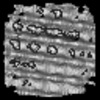 | |||||||||
|---|---|---|---|---|---|---|---|---|---|---|
| Title | Subtomogram average of the T. pseudonana PyShell | |||||||||
 Map data Map data | ||||||||||
 Sample Sample |
| |||||||||
 Keywords Keywords | marine diatoms / chloroplast / pyrenoid / photosynthesis / carbon fixation / rubisco | |||||||||
| Biological species |  Thalassiosira pseudonana (Diatom) Thalassiosira pseudonana (Diatom) | |||||||||
| Method | subtomogram averaging / cryo EM / Resolution: 20.0 Å | |||||||||
 Authors Authors | Demulder M / Righetto RD / Wietrzynski W / Lamm L / Engel BD | |||||||||
| Funding support | European Union, 1 items
| |||||||||
 Citation Citation |  Journal: Cell / Year: 2024 Journal: Cell / Year: 2024Title: Diatom pyrenoids are encased in a protein shell that enables efficient CO fixation. Authors: Ginga Shimakawa / Manon Demulder / Serena Flori / Akihiro Kawamoto / Yoshinori Tsuji / Hermanus Nawaly / Atsuko Tanaka / Rei Tohda / Tadayoshi Ota / Hiroaki Matsui / Natsumi Morishima / ...Authors: Ginga Shimakawa / Manon Demulder / Serena Flori / Akihiro Kawamoto / Yoshinori Tsuji / Hermanus Nawaly / Atsuko Tanaka / Rei Tohda / Tadayoshi Ota / Hiroaki Matsui / Natsumi Morishima / Ryosuke Okubo / Wojciech Wietrzynski / Lorenz Lamm / Ricardo D Righetto / Clarisse Uwizeye / Benoit Gallet / Pierre-Henri Jouneau / Christoph Gerle / Genji Kurisu / Giovanni Finazzi / Benjamin D Engel / Yusuke Matsuda /     Abstract: Pyrenoids are subcompartments of algal chloroplasts that increase the efficiency of Rubisco-driven CO fixation. Diatoms fix up to 20% of global CO, but their pyrenoids remain poorly characterized. ...Pyrenoids are subcompartments of algal chloroplasts that increase the efficiency of Rubisco-driven CO fixation. Diatoms fix up to 20% of global CO, but their pyrenoids remain poorly characterized. Here, we used in vivo photo-crosslinking to identify pyrenoid shell (PyShell) proteins, which we localized to the pyrenoid periphery of model pennate and centric diatoms, Phaeodactylum tricornutum and Thalassiosira pseudonana. In situ cryo-electron tomography revealed that pyrenoids of both diatom species are encased in a lattice-like protein sheath. Single-particle cryo-EM yielded a 2.4-Å-resolution structure of an in vitro TpPyShell1 lattice, which showed how protein subunits interlock. T. pseudonana TpPyShell1/2 knockout mutants had no PyShell sheath, altered pyrenoid morphology, and a high-CO requiring phenotype, with reduced photosynthetic efficiency and impaired growth under standard atmospheric conditions. The structure and function of the diatom PyShell provide a molecular view of how CO is assimilated in the ocean, a critical ecosystem undergoing rapid change. | |||||||||
| History |
|
- Structure visualization
Structure visualization
| Supplemental images |
|---|
- Downloads & links
Downloads & links
-EMDB archive
| Map data |  emd_18709.map.gz emd_18709.map.gz | 929.8 KB |  EMDB map data format EMDB map data format | |
|---|---|---|---|---|
| Header (meta data) |  emd-18709-v30.xml emd-18709-v30.xml emd-18709.xml emd-18709.xml | 14.5 KB 14.5 KB | Display Display |  EMDB header EMDB header |
| FSC (resolution estimation) |  emd_18709_fsc.xml emd_18709_fsc.xml | 2.4 KB | Display |  FSC data file FSC data file |
| Images |  emd_18709.png emd_18709.png | 94.8 KB | ||
| Masks |  emd_18709_msk_1.map emd_18709_msk_1.map | 1 MB |  Mask map Mask map | |
| Filedesc metadata |  emd-18709.cif.gz emd-18709.cif.gz | 4.3 KB | ||
| Others |  emd_18709_half_map_1.map.gz emd_18709_half_map_1.map.gz emd_18709_half_map_2.map.gz emd_18709_half_map_2.map.gz | 942.4 KB 942.4 KB | ||
| Archive directory |  http://ftp.pdbj.org/pub/emdb/structures/EMD-18709 http://ftp.pdbj.org/pub/emdb/structures/EMD-18709 ftp://ftp.pdbj.org/pub/emdb/structures/EMD-18709 ftp://ftp.pdbj.org/pub/emdb/structures/EMD-18709 | HTTPS FTP |
-Validation report
| Summary document |  emd_18709_validation.pdf.gz emd_18709_validation.pdf.gz | 777.2 KB | Display |  EMDB validaton report EMDB validaton report |
|---|---|---|---|---|
| Full document |  emd_18709_full_validation.pdf.gz emd_18709_full_validation.pdf.gz | 776.8 KB | Display | |
| Data in XML |  emd_18709_validation.xml.gz emd_18709_validation.xml.gz | 8 KB | Display | |
| Data in CIF |  emd_18709_validation.cif.gz emd_18709_validation.cif.gz | 10.2 KB | Display | |
| Arichive directory |  https://ftp.pdbj.org/pub/emdb/validation_reports/EMD-18709 https://ftp.pdbj.org/pub/emdb/validation_reports/EMD-18709 ftp://ftp.pdbj.org/pub/emdb/validation_reports/EMD-18709 ftp://ftp.pdbj.org/pub/emdb/validation_reports/EMD-18709 | HTTPS FTP |
-Related structure data
- Links
Links
| EMDB pages |  EMDB (EBI/PDBe) / EMDB (EBI/PDBe) /  EMDataResource EMDataResource |
|---|
- Map
Map
| File |  Download / File: emd_18709.map.gz / Format: CCP4 / Size: 1 MB / Type: IMAGE STORED AS FLOATING POINT NUMBER (4 BYTES) Download / File: emd_18709.map.gz / Format: CCP4 / Size: 1 MB / Type: IMAGE STORED AS FLOATING POINT NUMBER (4 BYTES) | ||||||||||||||||||||||||||||||||||||
|---|---|---|---|---|---|---|---|---|---|---|---|---|---|---|---|---|---|---|---|---|---|---|---|---|---|---|---|---|---|---|---|---|---|---|---|---|---|
| Projections & slices | Image control
Images are generated by Spider. | ||||||||||||||||||||||||||||||||||||
| Voxel size | X=Y=Z: 4.286 Å | ||||||||||||||||||||||||||||||||||||
| Density |
| ||||||||||||||||||||||||||||||||||||
| Symmetry | Space group: 1 | ||||||||||||||||||||||||||||||||||||
| Details | EMDB XML:
|
-Supplemental data
-Mask #1
| File |  emd_18709_msk_1.map emd_18709_msk_1.map | ||||||||||||
|---|---|---|---|---|---|---|---|---|---|---|---|---|---|
| Projections & Slices |
| ||||||||||||
| Density Histograms |
-Half map: #1
| File | emd_18709_half_map_1.map | ||||||||||||
|---|---|---|---|---|---|---|---|---|---|---|---|---|---|
| Projections & Slices |
| ||||||||||||
| Density Histograms |
-Half map: #2
| File | emd_18709_half_map_2.map | ||||||||||||
|---|---|---|---|---|---|---|---|---|---|---|---|---|---|
| Projections & Slices |
| ||||||||||||
| Density Histograms |
- Sample components
Sample components
-Entire : Thalassiosira pseudonana
| Entire | Name:  Thalassiosira pseudonana (Diatom) Thalassiosira pseudonana (Diatom) |
|---|---|
| Components |
|
-Supramolecule #1: Thalassiosira pseudonana
| Supramolecule | Name: Thalassiosira pseudonana / type: cell / ID: 1 / Parent: 0 |
|---|---|
| Source (natural) | Organism:  Thalassiosira pseudonana (Diatom) Thalassiosira pseudonana (Diatom) |
-Experimental details
-Structure determination
| Method | cryo EM |
|---|---|
 Processing Processing | subtomogram averaging |
| Aggregation state | cell |
- Sample preparation
Sample preparation
| Buffer | pH: 7 |
|---|---|
| Grid | Model: Quantifoil R2/1 / Material: COPPER / Mesh: 200 / Pretreatment - Type: GLOW DISCHARGE / Pretreatment - Time: 20 sec. |
| Vitrification | Cryogen name: ETHANE / Instrument: FEI VITROBOT MARK III |
- Electron microscopy
Electron microscopy
| Microscope | FEI TITAN KRIOS |
|---|---|
| Image recording | Film or detector model: GATAN K3 BIOQUANTUM (6k x 4k) / Average exposure time: 0.5 sec. / Average electron dose: 2.0 e/Å2 |
| Electron beam | Acceleration voltage: 300 kV / Electron source:  FIELD EMISSION GUN FIELD EMISSION GUN |
| Electron optics | Illumination mode: FLOOD BEAM / Imaging mode: BRIGHT FIELD / Cs: 2.7 mm / Nominal defocus max: 4.0 µm / Nominal defocus min: 2.0 µm / Nominal magnification: 42000 |
| Sample stage | Specimen holder model: FEI TITAN KRIOS AUTOGRID HOLDER / Cooling holder cryogen: NITROGEN |
| Experimental equipment |  Model: Titan Krios / Image courtesy: FEI Company |
 Movie
Movie Controller
Controller





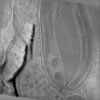



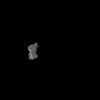
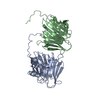
 Z (Sec.)
Z (Sec.) Y (Row.)
Y (Row.) X (Col.)
X (Col.)








